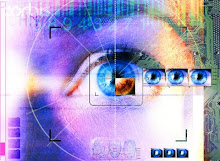The retina is a very thin tissue composed of neutral cells that is located at the back of the eye. Because of the complexity of the capillaries' structure that supply the retina with blood, each person's retina is unique. The blood vessels in the retina form such a complex netwok that identical or Siamese twins do not even share a similar pattern. The replication of a retina has been an impossible operation up until now, and a dead person's retina would deteriorate so fast that it can not be used for identity counterfeiting.
The retinal scan examines the blood vessel patterns of the retina, the nerve tissue lining the inside of the eye that is sensitive to light.
An infrared light source is used to illuminate the retina of the eye. The image of the enhanced blood vessel pattern of the retina is analyzed for characteristic points.
The uniqueness of the human retina and the impossibility of its replication made the retina scanning the most commmon technology relied on for high end access control security applications. The wide use of this technology in very high security environments such as nuclear research and weapons sites and communications control facilities is an incontrovertible evidence of its accuracy and invulnerability.
References:



Aucun commentaire:
Enregistrer un commentaire